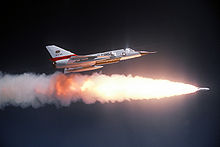AIR-2 Genie
| AIR-2 Genie | |
|---|---|
Solid fuel | |
Operational range | 6 miles (9.7 km) |
| Maximum speed | Mach 3.3 |
The
. Production ended in 1962 after over 3,000 were made, with some related training and test derivatives being produced later.Development

The interception of
The
The then top-secret project had various code names, such as Bird Dog, Ding Dong, and High Card. Full-scale development began in 1955, with test firing of inert warhead rockets commencing in early 1956. The final design carried a 1.5-
The new rocket entered service with the designation MB-1 Genie in 1957. The first interceptor squadrons to carry the MB-1 declared initial operational capability on 1 Jan. 1957, when a handful of rockets and 15
A live Genie was detonated only once, in

While in service with the U.S. Air Force, the Genie was carried operationally on the
The only other Genie user was Canada, whose
Safety features included final arming by detecting the acceleration and deceleration of a fast aircraft at high altitude. The weapon was built too early to use a permissive action link security device.[2]
The F-89J that was used to launch the only live test is on static display at the Montana Air National Guard in Great Falls, Montana.
Operators
- Canadian Forces Air Command
Surviving examples
Below is a list of museums which have a Genie rocket in their collection:
- Air Force Armament Museum, Eglin Air Force Base, Florida
- Halifax, Nova Scotia
- Hill Aerospace Museum, Ogden, Utah
- Akron-Canton Regional Airport, OhioATR-2 with MF-9 trailer
- Museum of Aviation at Robins Air Force Base, Georgia ATR-2N with MF-9 trailer[9]
- National Museum of the United States Air Force, Wright-Patterson Air Force Base, Ohio[10]
- Oregon Military Museum at Camp Withycombe, Clackamas, Oregon
- Pima Air & Space Museum, Tucson, Arizona Inert round with trailer
- Selfridge Air National Guard Base Museum, Harrison Township, Michigan
- , Canada
- Ellsworth Air and Space Museum at Ellsworth Air Force Base, Rapid City, South Dakota
- 3 Wing, Saguenay, Quebec, Canada
- Comox Air Force Museum, CFB Comox, 19 Wing, Comox, British Columbia, British Columbia, Canada
- Vermont National Guard Library and Museum, Camp Johnson, Colchester, Vermont
- Jimmy Doolittle Air & Space Museum, Travis Air Force Base, California
- National Atomic Testing Museum, Paradise, Nevada
- Malmstrom Air Force Base Museum, Great Falls, Montana
- National Museum of Nuclear Science & History, Albuquerque, New Mexico
On 31 January 2024 a dilapidated old rocket, later found to be an inert AIR-2 Genie, was reported to police in the city of Bellevue, Washington after being offered as a donation to the National Museum of the U.S. Air Force in Dayton, Ohio.[11][12]
See also
References
- ^ "Historical Snapshot: MB-1/AIR-2 Genie Missile". Boeing. Retrieved 24 May 2023.
- ^ OCLC 244771111.
- ^ Parsch, Andreas (2002). "Douglas AIR-2 Genie". Designation-Systems.Net.
- OCLC 17550154.
- ^ SHOTS DIABLO TO FRANKLIN PRIME The Mid-Series Tests of the PLUMBBOB Series 15 JULY – 30 AUGUST 1957 Archived 16 September 2012 at the Wayback Machine
- CTBTO. 19 July 1957. Retrieved 17 February 2014.
- ^ Defense Threat Reduction Agency. Public Affairs. Factsheet. Operation Plumbbob. Archived 22 July 2012 at the Wayback Machine
- ^ Attachment 12. Preliminary report. Operation Plumbbob. Nevada Test Site, May-September 1957. Project 2.9 NUCLEAR RADIATION RECEIVED BY AIRCREWS FIRING THE MB-1 ROCKET.
- ^ Museum of Aviation Website Archived 28 September 2007 at the Wayback Machine
- ^ "McDonnell Douglas Air-2A Genie Rocket." National Museum of the United States Air Force. Retrieved: 9 August 2015.
- ^ Matza, Max (3 February 2024). "Inert nuclear missile found in US man's garage". BBC News. Retrieved 3 February 2024.
- ^ Blatchford, Taylor (2 February 2024). "Police investigate military-grade rocket in Bellevue garage". Seattle Times. Retrieved 3 February 2024.
